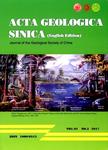Xinjiangoxylon ***.,a New Gymnosperm from the Latest Permian of China
Xinjiangoxylon ***.,a New Gymnosperm from the Latest Permian of China作者机构:State Key Laboratary of Biogeology and Environmental Geology Faculty of Earth SciencesChina University of Geosciences Centre de Recherche sur la Paleobiodiversite et les PaleoenvironnementsUniversite Pierre et Marie CurieParis 75252France Shenyang Institute of Geology and Mineral ResourcesMinistry of National Land and Resources
出 版 物:《Acta Geologica Sinica(English Edition)》 (地质学报(英文版))
年 卷 期:2014年第88卷第5期
页 面:1356-1363页
核心收录:
学科分类:070903[理学-古生物学与地层学(含:古人类学)] 0709[理学-地质学] 07[理学]
基 金:supported by National Natural Science Foundation of China(Grant No.40972002,41272024) China Geological Survey (Grant No.1212011120142) State Key Laboratory of Biogeology and Environmental Geology(Grant No. GBL11302)
主 题:Paleobotany taxonomy Gymnospermae mass extinction Late Permian Xinjiang AR
摘 要:Following the greatest known end-Permian mass extinction plants have low diversity. Lycopsids and conifers dominated on land. A new gymnosperm Xinjiangoxylon gen. nov. is proposed based on a woody stem specimen collected from the Upper Permian (latest, Changhsingian) Upper Guodikeng Formation of the Taoshuyuan section, Turpan, Xinjiang Uygur Autonomous Region, Northwest China. The decorticated stem is characterized by a complex pith, endarch primary xylem and a thick secondary xylem cylinder. Numerous petrified woods were found in the Changhsingian at this section. However, there are rare wood fossils in the Early Triassic. The abrupt decrease of fossil woods worldwide relates to the crisis at the end of the Permian. Xinjiangoxylon turpanense gen et. sp. nov. appears to represents one gymnosperm that existed in the latest Permian.



